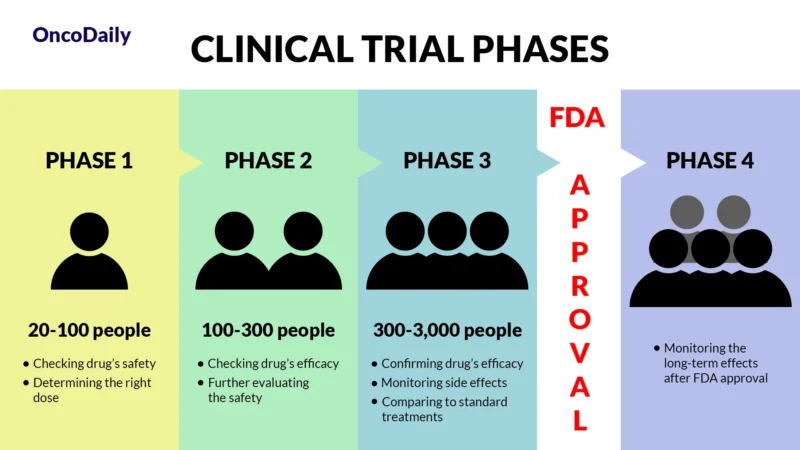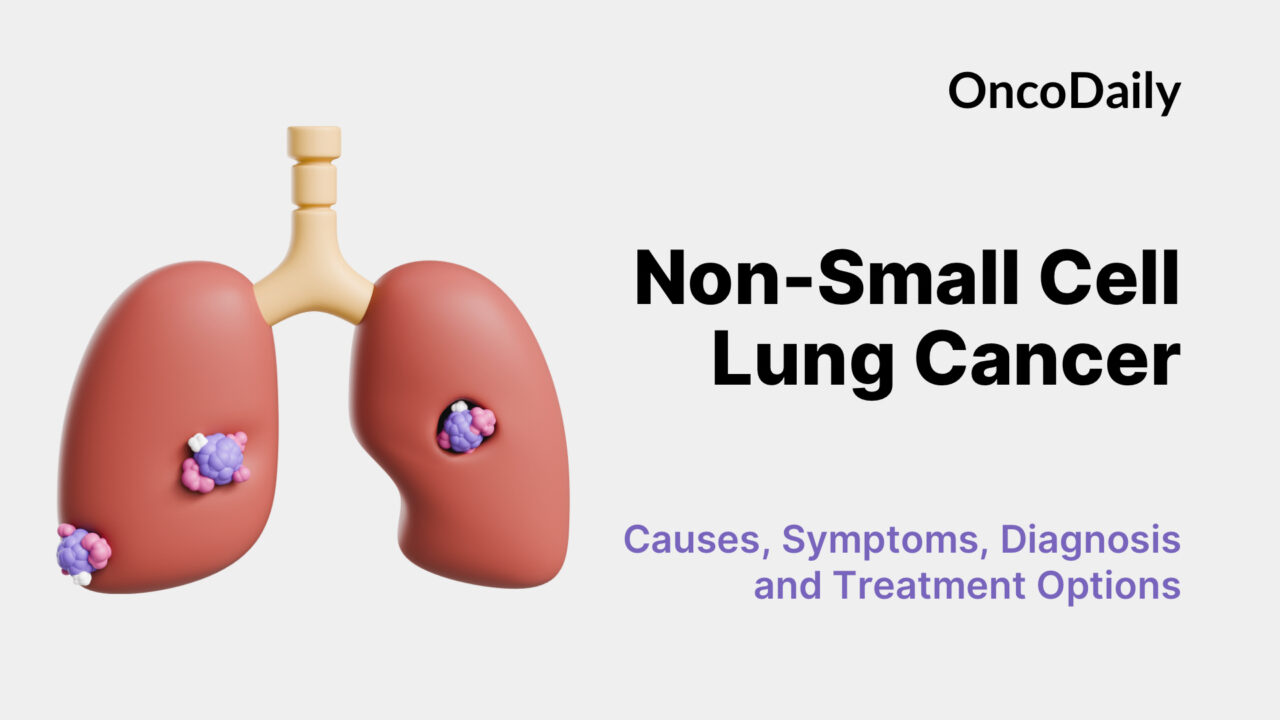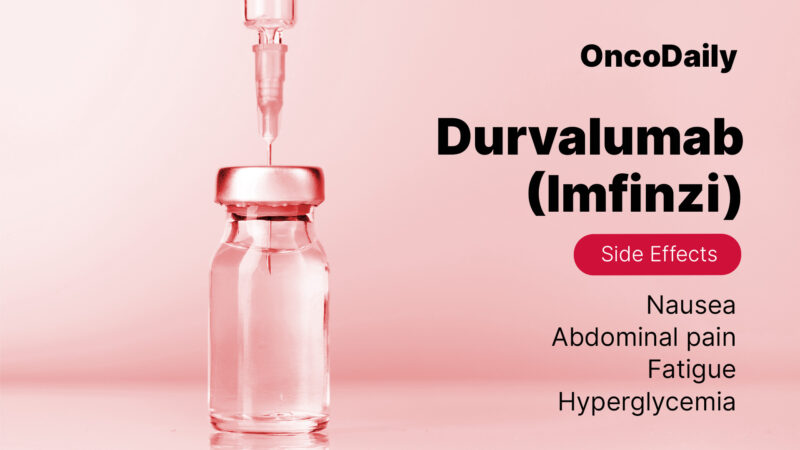Durvalumab is a cancer immunotherapy designed to help the immune system recognize and attack cancer cells. It is approved for several advanced cancers, including lung and bladder cancer. Durvalumab works by helping your body’s immune system attack cancer cells more effectively. This article covers the key information patients need to know—how durvalumab works, its approved uses, dosage and administration, possible side effects, and what to expect during treatment.
What is Durvalumab and How Does It Work?
Durvalumab (Brand name Imfinzi) is a type of medication called an immune checkpoint inhibitor. Now, that might sound complicated, but here’s how it works in simpler terms: Cancer cells can sometimes hide from your immune system by sending signals that tell the immune system to leave them alone. Durvalumab blocks one of these “stop signals,” known as PD-L1. When PD-L1 is blocked, the immune system gets the green light to attack and destroy cancer cells more effectively.
Durvalumab is special because it doesn’t directly kill the cancer cells. Instead, it boosts the body’s natural defenses, helping the immune system do the heavy lifting.

Learn more about How Does Immunotherapy Work on OncoDaily.
What Is a Clinical Trial and Why Does It Matter?
A clinical trial is a research study designed to test new drugs and treatments in patients to determine their safety and effectiveness. Before Durvalumab was approved, it went through multiple phases of clinical trials to assess how well it worked, what side effects it caused, and whether it was better than existing treatments. Clinical trials are essential because they provide scientific evidence that a drug can help patients while ensuring it is safe for widespread use.

What Does FDA Approval Mean?
When a drug receives FDA approval, it means that after rigorous testing in clinical trials, it has been shown to be both safe and effective for treating a specific condition. This approval makes the drug widely available for doctors to prescribe and helps patients access new, cutting-edge treatments sooner.
What Cancers Does Durvalumab Treat?
Durvalumab, also known as Imfinzi, is a type of immunotherapy that helps your immune system recognize and attack cancer cells. Since 2017, it has gained FDA approval for treating several difficult-to-treat cancers, including non-small cell lung cancer (NSCLC), small cell lung cancer (SCLC), bladder cancer, endometrial cancer, and biliary tract cancer.
Durvalumab for Lung Cancer
The journey began in 2017, when durvalumab was approved for bladder cancer that had progressed after chemotherapy. Soon after, it made a big impact in stage III non-small cell lung cancer (NSCLC). The PACIFIC trial showed that patients who received durvalumab after completing chemotherapy and radiation had a median progression-free survival (PFS) of 16.8 months, compared to just 5.6 months for those who didn’t receive it. This approval gave hope to patients who had limited options before.

Read more about Non-Small Cell Lung Cancer: Causes, Symptoms, Diagnosis, Treatment Options, and Latest 2025 Advances in Targeted and Immunotherapy on OncoDaily.
In 2020, durvalumab was approved for extensive-stage small cell lung cancer (ES-SCLC) after the CASPIAN trial showed it improved overall survival (OS) to 13 months, compared to 10.3 months with chemotherapy alone. At 18 months, 34% of patients were still alive with durvalumab, versus 25% in the standard group.
Durvalumab’s success continued in 2024 with approvals for limited-stage SCLC. In the ADRIATIC trial, patients with limited-stage SCLC who received durvalumab after chemo and radiation had a median overall survival of 55.9 months, compared to 33.4 months with placebo. Progression-free survival was also much better (16.6 months vs. 9.2 months).
Durvalumab for Biliary tract Cancer
For biliary tract cancer, which is hard to treat, durvalumab was approved in 2022 based on the TOPAZ-1 trial. This study showed that combining durvalumab with chemotherapy significantly improved survival, with 24.9% of patients alive at 2 years, compared to 10.4% in the control group. It also delayed cancer growth and had a safety profile similar to standard treatment.
Durvalumab for Endometrial Cancer
In 2023, the DUO-E trial led to durvalumab’s approval for advanced endometrial cancer. When combined with chemotherapy, durvalumab helped patients live longer without cancer progression—especially those with genetic changes like mismatch repair deficiency (dMMR).
Durvalumab for Bladder Cancer
Finally, the NIAGARA trial showed that in patients with muscle-invasive bladder cancer (MIBC), adding durvalumab to chemotherapy before surgery—and continuing it afterward—led to a 24-month event-free survival of 67.8%, compared to 59.8% with chemo alone. Overall survival at 2 years was also higher: 82.2% in the durvalumab group vs. 75.2% in the control group.

Read more about Immunotherapy for Urothelial Cancer: Types, Success Rate, Side Effects on OncoDaily.
Thanks to these studies, durvalumab has become a key player in cancer treatment. Whether it’s lung, bladder, uterine, or bile duct cancer, this immunotherapy is helping more people live longer with fewer cancer-related setbacks.
How Effective Is Durvalumab?
The results from clinical trials have shown that durvalumab can have a significant impact on cancer treatment. For example, in lung cancer, patients who received durvalumab after chemotherapy had a much longer period without cancer growth compared to those who didn’t receive the drug. In some trials, patients with advanced cancers saw better survival rates, meaning they lived longer and had fewer symptoms.
For bladder cancer, when combined with chemotherapy, durvalumab improved survival outcomes, meaning patients had a better chance of living longer without their cancer progressing. It’s this kind of evidence that has helped make durvalumab a crucial part of cancer treatment today.
What to Expect During Treatment with Durvalumab?
Imfinzi is given through an IV infusion, which means a needle will be placed in your vein to deliver the medication directly into your bloodstream. The treatment takes about an hour. The schedule can vary depending on the type of cancer being treated, but it’s typically administered every two or four weeks. You might feel some discomfort during the infusion, but most patients tolerate it well.
During the treatment, your healthcare team will keep a close eye on you to make sure everything is going smoothly. You may be given some medications beforehand to prevent side effects, and your doctors will monitor you for any signs of reactions after the infusion.
Durvalumab Side Effects: What You Should Know?
Durvalumab is an immunotherapy drug used to treat cancers like non-small cell lung cancer, small cell lung cancer, and bladder cancer. While effective, it can cause side effects ranging from mild to severe, so it’s important to be aware of them.
Common side effects
Common side effects include respiratory issues like cough and shortness of breath, which can sometimes lead to lung inflammation (pneumonitis). Gastrointestinal symptoms, such as nausea, constipation, and loss of appetite, may also occur. Fatigue and skin reactions like rashes and itching are frequent as well. These symptoms can affect daily life but can usually be managed with medications.
Less common and serious side effects
Less common but more serious side effects involve immune-related conditions, such as liver (hepatitis), colon (colitis), or kidney (nephritis) inflammation. Symptoms like jaundice, abdominal pain, or persistent diarrhea should be reported to a doctor. Imfinzi can also cause thyroid issues, leading to fatigue, weight gain, and cold sensitivity. Rare neurological symptoms like numbness or tingling may also occur.
Serious side effects include allergic reactions with symptoms like difficulty breathing or facial swelling, requiring immediate medical attention. Severe lung issues and immune-related side effects may require stopping the treatment or using immunosuppressive drugs to manage inflammation.
Managing side effects involves regular monitoring of thyroid, liver, and kidney functions. For milder symptoms, doctors may prescribe medications for nausea, pain, or itching. In cases of more severe side effects, immunosuppressive drugs may be necessary, and treatment adjustments may be made.

Long-Term Outlook: What Can You Expect?
Durvalumab is not a cure, but for many patients, it can help manage cancer for months or even years. The goal of treatment is often to keep the cancer from growing or spreading while also maintaining a good quality of life. The treatment will typically continue until the cancer progresses or the side effects become too much to handle.
Your doctor will help you understand how long you can expect to be on the treatment and what the next steps will be if the cancer starts to come back.
What Should You Avoid?
While on Imfinzi, you should avoid live vaccines, as they might not work as well due to the way the treatment affects your immune system. Smoking can also reduce the effectiveness of the drug, so it’s a good idea to stop smoking while undergoing treatment. Your doctor will give you a list of things to avoid and will guide you through the process of staying safe during treatment.
Real-World Effectiveness
Clinical trials show that durvalumab can be very effective, but every patient is different. Some people may experience long-term benefits, while others might find that the cancer starts to progress after a period of time. However, many patients have seen significant improvements in their survival rates and quality of life, and ongoing research continues to refine its use.
Looking Ahead – The Future of Cancer Treatment
Durvalumab is already making a big difference in the treatment of certain cancers, and researchers are optimistic about its future. As more studies are conducted, it may be approved for other types of cancer, or it may be used in combination with other treatments to increase its effectiveness. This gives hope for new possibilities in cancer treatment, where durvalumab could help more patients live longer and with fewer symptoms.
Ongoing trials with Durvalumab
Researchers are continuing to study durvalumab in combination with other treatments to find better ways to treat different types of cancer. Here are some of the ongoing clinical trials:
Liver Cancer (Intrahepatic Cholangiocarcinoma)
A Phase 2 study called the HAIC-quad trial (NCT06859684) is testing a new combination of treatments for people with advanced or spreading bile duct cancer inside the liver. This includes hepatic artery infusion chemotherapy (HAIC) along with durvalumab and another drug called lenvatinib. The goal is to deliver chemotherapy directly to the liver, which may help reduce side effects and improve treatment results compared to standard approaches.
Liver Cancer (Unresectable Hepatocellular Carcinoma)
A Phase 1/2 trial (NCT06911255) is looking at how safe and effective it is to combine durvalumab and tremelimumab with a procedure called TACE (transarterial chemoembolization). This treatment is for liver cancer that can’t be removed with surgery. The study is focused on seeing how long patients can live without their cancer getting worse, as well as how well the treatment works overall and how safe it is.
Small Cell Lung Cancer (Extensive-Stage)
Another early-stage study is exploring a combination of tarlatamab, YL201, and possibly durvalumab (an anti-PD-L1 therapy) for patients with extensive-stage small cell lung cancer. This trial (NCT06898957) is mainly checking how safe the treatment is and whether patients can tolerate it well.
If you’re a healthcare provider, access the professional version here.
